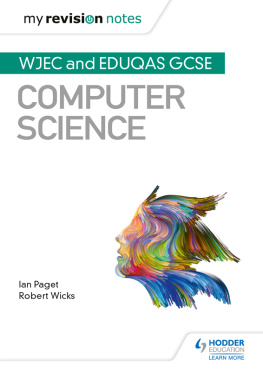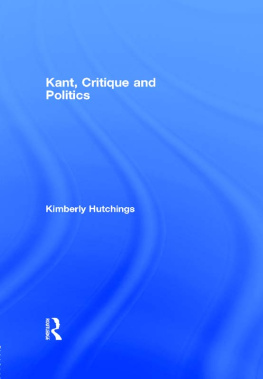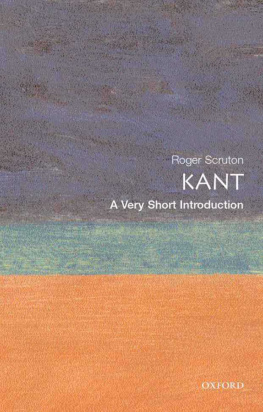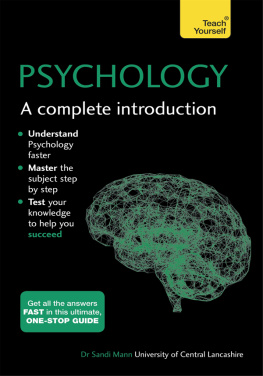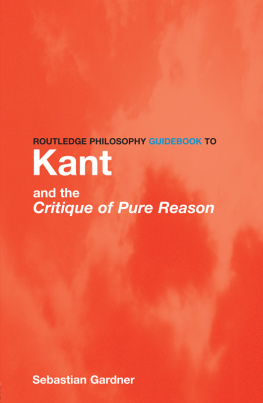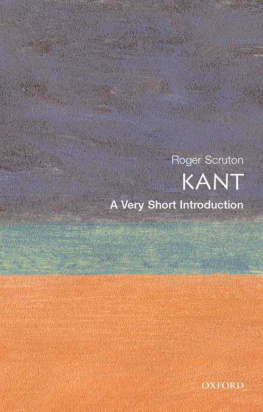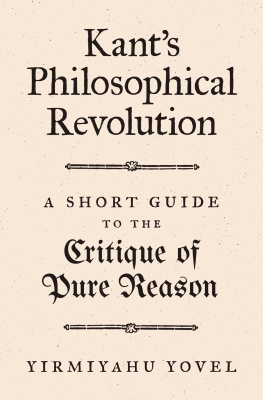KANT
A Complete Introduction
Robert L. Wicks
To Valentina, my courageous daughter
Robert L. Wicks is an Associate Professor of Philosophy at the University of Auckland, New Zealand. He is the author of Kant On Judgement (2007), along with books on Schopenhauer, Hegel, Nietzsche, Modern French Philosophy and European Aesthetics.
Contents
Introduction
Immanuel Kants philosophy is one of the most profound and influential ever to have been written. It is also among the more complicated philosophies, where each technical term compares to a part of a cars engine, where all of the parts are intended to work in harmony to produce a smoothly running mechanism. As Kant composed it, a few of his philosophys parts do not fit with each other perfectly, and it has become the business of contemporary Kant scholars to redesign these parts to produce a more thoroughly coherent and persuasive Kantian philosophy. In this book, our goal will be to describe the classical design of Kants philosophical engine as he intended it, the kind of historical terrain upon which it was supposed to run, and the spiritual destination towards which it was meant to take us.
Kant was writing during the late 1700s, and at the forefront of his theorizing were problems generated by religion, science and morality. These themes define the intellectual atmosphere of his thought. At the most basic level is the problem of how we can be free, if scientific thought can predict everything that happens. We have all wondered about, and perhaps dreamed or even feared, what it would be like, if science were perfect and we could predict all that will happen. Kant considered this, and then became puzzled about what would become of God and our sense of morality. How can one blame or praise someone, if their actions at age 80 were already knowable when they were only three years old? The problem of freedom versus determinism is at the centre of Kants philosophy.
Perhaps you have heard of Kant only in passing and were curious about what his philosophy actually says. Perhaps you are a student studying Kant who would like to read a book that explains his views briefly, but also accurately, reliably, memorably and easily. Perhaps you are a specialist in a field other than philosophy who has encountered some interesting references to Kants philosophy. Perhaps you studied Kant once, long ago, and would like to refresh your memory of his central ideas. This book is written for you. It aims to be self-contained and self-explanatory, such that no background in philosophy will be necessary to understand it. The relevant background ideas will be provided as we go along.
Kant is known mainly from three main books that he wrote, each of whose titles begins with the word critique. These books are frequently referred to as Kants three critiques and his philosophy is often called, appropriately, the critical philosophy. This book will thus have a part devoted to each of Kants Critiques. The first Critique is concerned with the question of truth. The second, with the question of goodness. The third is concerned with beauty. Residing accordingly at the core of Kants philosophy and guiding our study of it will be truth, goodness and beauty the most famous triad in the history of Western philosophy.
We will focus upon Kants three Critiques in light of Kants own statement at the end of the first Critique, of three questions that cover all of our interests insofar as we are rational beings. These are:
What can I know?
What ought I to do?
What may I hope?
We will consequently look at Kants theory of knowledge, his moral theory, and his aesthetic and political theory, especially insofar as they bear on our moral destination. Kants third question is about what we may hope, if we do our duty and consequently deserve happiness. It concerns the ideal, peaceful world that awaits, if everyone were to realize their potential as rational beings.
Our books title is Kant A Complete Introduction. It aims at completeness in the modest sense of trying to cover the key aspects of Kants philosophy. Thousands of books have been written on Kants philosophy, many of which have stimulated further books on Kant in their wake. In this respect, his thought continues to live and grow, expanding our horizons to defy any sense of completeness.
It will help to mention here at the outset, that the quotations from Kant have been taken from editions in the public domain and/or have been translated by the present author. In the field of Kant scholarship, the standard way to refer to quotes from the Critique of Pure Reason, is to cite the edition and page number after the quote. The first edition (1781) is signified by the letter A; the second edition (1787), by the letter B. A reference that reads A51/B75, for example, signifies that the original German passage is located in the first edition on page 51, and in the second edition on page 75. We will follow this standard format in our text, as we investigate how powerful the human mind really is.
How to use this book

This Complete Introduction from Teach Yourself includes a number of special boxed features, which have been developed to help you understand the subject more quickly and remember it more effectively. Throughout the book you will find these indicated by the following icons: |
| The book includes concise quotes from the philosopher under discussion in each chapter. They are referenced so that you can include them in essays if you are unable to get your hands on the source. |
| The key ideas are highlighted throughout the chapters, and distil the most important points and thoughts. If you have only half an hour to go before an exam, scanning through these would be a very good way of spending your time. |
| The study questions at the end of each chapter are designed to help you ensure that you have taken in the most important concepts from the chapter. Answers are not supplied, as the questions are intended to be starting points for further study. |
| The spotlight boxes offer interesting or amusing anecdotes to help bring the philosophers and their ideas to life. |
| The dig deeper boxes give you ways to explore topics in greater depth than is possible in this introductory level book. |

Section One:
Background
Life and writings


